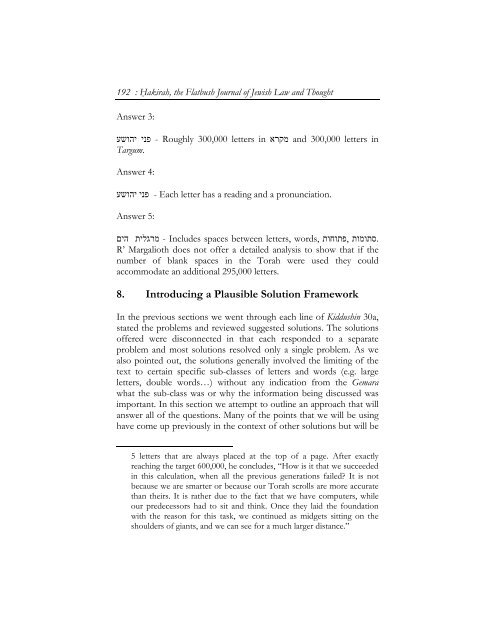Symmetrically Designed Sifrei Torah: A Quantitative Analysis - Hakirah
Symmetrically Designed Sifrei Torah: A Quantitative Analysis - Hakirah
Symmetrically Designed Sifrei Torah: A Quantitative Analysis - Hakirah
Create successful ePaper yourself
Turn your PDF publications into a flip-book with our unique Google optimized e-Paper software.
192 : Hạkirah, the Flatbush Journal of Jewish Law and Thought<br />
Answer 3:<br />
and 300,000 letters in מקרא - Roughly 300,000 letters in פני יהושע<br />
Targum.<br />
Answer 4:<br />
pronunciation. - Each letter has a reading and a פני יהושע<br />
Answer 5:<br />
.סתומות ,פתוחות words, - Includes spaces between letters, מרגלית הים<br />
R’ Margalioth does not offer a detailed analysis to show that if the<br />
number of blank spaces in the <strong>Torah</strong> were used they could<br />
accommodate an additional 295,000 letters.<br />
8. Introducing a Plausible Solution Framework<br />
In the previous sections we went through each line of Kiddushin 30a,<br />
stated the problems and reviewed suggested solutions. The solutions<br />
offered were disconnected in that each responded to a separate<br />
problem and most solutions resolved only a single problem. As we<br />
also pointed out, the solutions generally involved the limiting of the<br />
text to certain specific sub-classes of letters and words (e.g. large<br />
letters, double words…) without any indication from the Gemara<br />
what the sub-class was or why the information being discussed was<br />
important. In this section we attempt to outline an approach that will<br />
answer all of the questions. Many of the points that we will be using<br />
have come up previously in the context of other solutions but will be<br />
5 letters that are always placed at the top of a page. After exactly<br />
reaching the target 600,000, he concludes, “How is it that we succeeded<br />
in this calculation, when all the previous generations failed? It is not<br />
because we are smarter or because our <strong>Torah</strong> scrolls are more accurate<br />
than theirs. It is rather due to the fact that we have computers, while<br />
our predecessors had to sit and think. Once they laid the foundation<br />
with the reason for this task, we continued as midgets sitting on the<br />
shoulders of giants, and we can see for a much larger distance.”
















